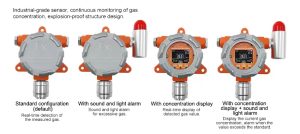Industrial safety and pollution control are paramount concerns in today's industrial landscape. With the growing emphasis on environmental protection and workplace safety, the development and implementation of advanced technologies have become crucial. Gas sensors have emerged as a transformative solution for revolutionizing industrial safety and pollution control. These sensors play a vital role in detecting and monitoring hazardous gases, enabling early warning systems, and facilitating effective control measures. This article explores the significant contributions of gas sensors in enhancing industrial safety and addressing pollution challenges.
Importance of Industrial Safety
Industrial facilities are susceptible to various hazards, including toxic gases, flammable substances, and oxygen deficiency. Failure to detect and respond promptly to these threats can lead to accidents, injuries, and even loss of life. That makes industrial safety a top priority for all stakeholders involved. Gas sensors act as essential tools for ensuring a safe working environment by continuously monitoring the presence of dangerous gases in real-time. They enable early detection of potential hazards, alerting operators and triggering necessary safety protocols.
Role of Gas Sensors in Hazardous Gas Detection
Gas sensors are specifically designed to detect and measure specific gases present in the surrounding environment. They utilize various detection principles such as electrochemical, semiconductor, infrared, and catalytic combustion. When a target gas comes into contact with the sensor, it triggers a chemical or physical reaction, leading to a measurable response. This response is then converted into an electrical signal, which is analyzed and interpreted to determine the gas concentration.
Gas sensors are widely used in industrial settings to monitor hazardous gases such as carbon monoxide (CO), hydrogen sulfide (H2S), ammonia (NH3), methane (CH4), and volatile organic compounds (VOCs). By continuously monitoring gas levels, these sensors provide early warnings to prevent accidental exposures, allow for timely evacuations, and facilitate prompt corrective actions.
Enhancing Workplace Safety with Gas Sensor Networks
Traditionally, gas detection systems relied on individual sensors installed in specific locations. However, the integration of gas sensors into a networked system has revolutionized workplace safety. Multiple sensors can now be interconnected and centrally managed, allowing for comprehensive monitoring and improved situational awareness. Gas sensor networks provide real-time data and enable remote access, enabling operators to monitor multiple areas simultaneously and respond promptly to any detected anomalies.
Furthermore, advancements in wireless communication technologies have facilitated the deployment of wireless gas sensor networks. These networks offer greater flexibility, scalability, and cost-effectiveness compared to traditional wired systems. They can be easily extended or reconfigured as needed, providing enhanced coverage and adaptability in industrial environments.
Pollution Control and Environmental Monitoring
In addition to industrial safety, gas sensors also play a significant role in pollution control and environmental monitoring. Industries that emit gases and volatile compounds during their processes need to comply with stringent environmental regulations. Gas sensors enable continuous monitoring of emissions, ensuring compliance and minimizing the impact on the environment.
Gas sensors are widely used in industries such as manufacturing, oil and gas, chemical, and wastewater treatment plants. They help identify leakages, measure pollutant concentrations, and enable process optimization for reducing emissions. By providing accurate and reliable data, gas sensors assist in maintaining air quality standards and protecting ecosystems.
Future Perspectives and Challenges
The field of gas sensor technology continues to evolve, driven by ongoing research and technological advancements. Emerging trends include the miniaturization of sensors, improved selectivity and sensitivity, and the development of multi-gas detection capabilities. These advancements will further enhance industrial safety and pollution control measures.
However, several challenges need to be addressed for the widespread adoption of gas sensors. Calibration and maintenance of sensors, cross-sensitivity issues, and false alarms are some of the technical challenges that require attention. Moreover, cost considerations, especially for deploying large-scale gas sensor networks, can be a barrier in certain industries.
Conclusion
Gas sensors have proven to be indispensable tools for revolutionizing industrial safety and pollution control. They provide crucial information for timely detection of hazardous gases, enabling effective response measures and mitigating risks. Gas sensor networks offer improved situational awareness an
 : +86 155 8830 2704
: +86 155 8830 2704 : jxdziot@gmail.com
: jxdziot@gmail.com
